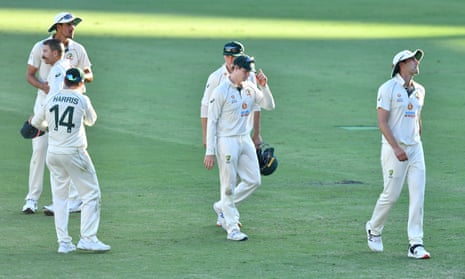It is probably hackery to roll out Lady Bracknell’s most famous line in another reworked form, but great lines are great because they are universal. In this context: “To lose one home series to India, Mr Paine, may be regarded as a misfortune; to lose both looks like carelessness.”
Two years ago Australians were, by and large, willing to accept being beaten 2-1 by a visiting India. The circumstances were special. Australia’s Test team was dizzy after the Cape Town sandpaper circus, Steve Smith and David Warner were comfortably the two best batsmen in the country and were missing on suspension, and India brought a once-in-a-generation assembly of fast-bowling quality to take advantage of their absence.
But losing again two years later, with Smith playing all four Tests and Warner two, with Australia’s next generation of batting having made strides in the interim, and with India’s five pace weapons reduced by injury to three, then two, then one, then none as the series went on, will be greeted differently.
Australians are not used to this sort of thing. For the longest time there was a set method to these tours. India would bring spinners and medium-pace swingers who would get belted about. Australia would turn out forests of fast bowlers against largely diminutive Indian batsmen who did not handle the pace and bounce of local pitches. This would be inverted when Australia toured India and got tied in knots, but those games were not on free-to-air television in every living room all summer long.
So to change this up to a situation in which an Indian team can play Australia’s game and win, bowling faster and smarter, spinning better, and batting with more toughness and application, is quite the mental adjustment. Or to shift our quotes to the contemporary, take sportswriter Daniel Cherny: “There is nothing like a Test series loss at home to invoke the inner national selector in every single person you know.”
Quite so, and most positions are being questioned. Tim Paine as captain, Justin Langer as coach, Warner’s durability, Mitchell Starc’s reliability, Matthew Wade’s desirability, Nathan Lyon’s incisiveness. Joe Burns got discarded, Will Pucovski got hurt, Travis Head got sidelined, Marnus Labuschagne got cocky, Marcus Harris got lucky, Cameron Green got no wickets. The only players likely to get an unqualified pass will be Smith, Pat Cummins and Josh Hazlewood.
Which is not to say that these rumblings should be met with action. Sporting audiences often have a problem grasping the basic conceit of the contest: that if someone wins then someone has to lose. The records of the best cricketers show more bad days than good. For Australia right now, there are no wicketkeepers in first-class cricket piling up runs, no good captaincy candidates beyond Cummins who has a fast-bowling workload, no domestic spinners indicating a readiness to step up.
There are more options with batting, and obvious problems. The openers beyond Warner have been poor, aside from one glance of Pucovski who has apparently been cursed by a witch at birth. Wade deserved his recall but has not made good on it across two home summers. Too much relies on Smith, who showed this summer that he cannot do it every single time. There have only been five Tests in which Smith has been out in both innings for single figures: Australia lost all of them, and one was in this series at Melbourne.
But that match aside, the problem was not really the batting, it was being unable to bowl India out. Twice Australia had the deck stacked in their favour: on a final day pitch with a deep bank of runs and a first-choice quintet. There is an inevitability to these days. A ball will eventually misbehave or a mistake will be made, and a batsman will fall. Except this time, India harnessed inevitability to their own ends.
This is the concern for Australia: add Sydney and Brisbane to the final day at Headingley in 2019, and you have three matches in the last dozen where Australia could not beat a team batting last chasing over 300. This from the same attacks that bowled out England for 67 in Leeds and India for 36 in Adelaide. Before the current series there was a popular line of broadcast chatter about whether Starc, Cummins, Hazlewood and Lyon formed Australia’s best attack of all time. It is hard to imagine earlier iterations letting opponents off that particular hook.
As is always the way, these results will be framed in terms of what they mean for the Ashes later this year. England can see that teams willing to counterattack the Australians can unsettle them. Australia will know that there are still gaps in the team to fill and problems, may they be tactical or mental, to address. Right now, those look like vulnerabilities that England could exploit. But then, like Lady Bracknell’s best, I am pretty sure we have heard that one before.

Comments (…)
Sign in or create your Guardian account to join the discussion